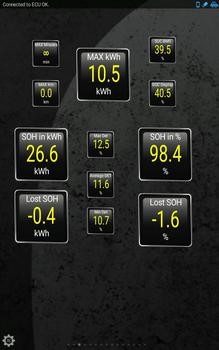Torque Pro is a popular OBD2 application used by Chevy Volt owners to monitor various vehicle parameters. One crucial parameter is the “Friction Brake Active” PID, which indicates whether the traditional friction brakes are engaged. This article delves into understanding this PID, particularly in the context of a Chevy Volt, using Torque Pro.
Torque Pro allows users to create custom dashboards to display real-time data from the vehicle’s OBD2 port. While pre-built dashboards exist, understanding the underlying data and potential limitations is essential. One common challenge with Torque Pro is its inability to handle complex calculations or “if statements.” This limitation can lead to counterintuitive displays, particularly when dealing with parameters like State of Health (SOH) in electric vehicles.
Let’s examine a practical example. A Torque Pro dashboard displaying data from a well-used Chevy Volt might show a SOH of 98.4%, indicating a 1.6% capacity loss from the original 27kWh battery, equating to approximately 0.4kWh. This is easily understandable.
However, in a newer Chevy Volt, the same Torque Pro dashboard might display a SOH above 100% and a positive value for lost kWh.
This seemingly illogical reading stems from the Volt’s battery management system, which includes a hidden buffer of approximately 10% capacity. Torque Pro, lacking the ability to incorporate this buffer logic into its calculations, simply adds the buffer to the SOH. Consequently, until the buffer is depleted, the SOH appears inflated, and the lost kWh appears as a positive value because it’s still within the buffer zone.
The “Friction Brake Active” PID, when read alongside other data points in Torque Pro, can provide valuable insights into the Volt’s braking system behavior. For instance, understanding when the friction brakes are activated in conjunction with regenerative braking can help diagnose potential issues or optimize driving habits for maximum efficiency.
Ultimately, while Torque Pro offers valuable data access for Chevy Volt owners, its limitations necessitate careful interpretation of the results. Understanding the nuances of parameters like the “Friction Brake Active” PID and the impact of the battery buffer on SOH calculations is crucial for accurately assessing vehicle performance and health. More sophisticated diagnostic tools with advanced logic capabilities, like SoulEVspy or OVMS, would offer a more intuitive and accurate representation of these complex systems. However, for those utilizing Torque Pro, a thorough understanding of these limitations is essential. By recognizing these nuances, Chevy Volt owners can leverage Torque Pro effectively to monitor their vehicles and gain insights into their operation.
